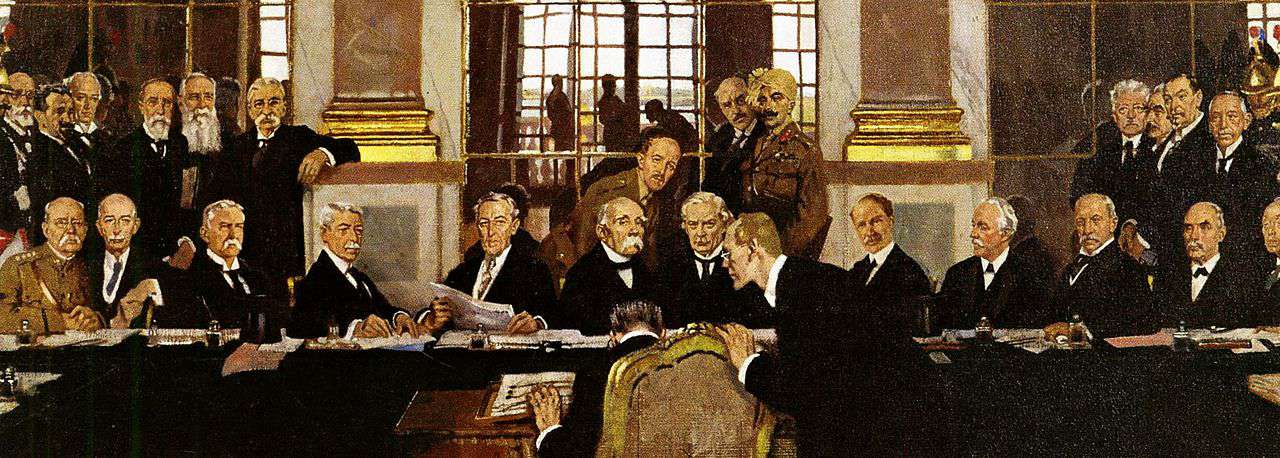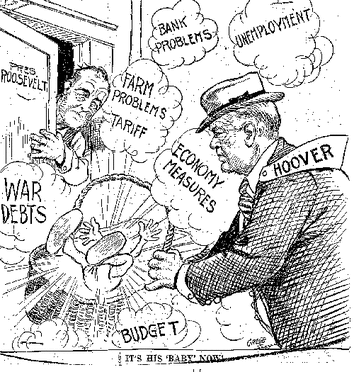Jed Quiaoit
VladimirGenkovski
AP World History: Modern 🌍
577 resourcesSee Units
Basis of Postwar Economy: The Treaty of Versailles
Fast forward to the day the Germans surrendered, and WWI ended: November 11, 1918. The victorious alliance convened in France as part of the Treaty of Versailles, a postwar conference in which spoils were split and losers were penalized with reparations (war payments) and dissolution/reduction of territories. It also established the League of Nations, an international organization designed to prevent future conflicts.
The treaty imposed significant territorial losses on Germany, including the loss of all its colonies, the transfer of the Sudetenland to Czechoslovakia, and the transfer of the Polish corridor to Poland, which separated East Prussia from the rest of Germany. The treaty also established a demilitarized zone along the Rhineland.
The treaty also imposed heavy reparations payments on Germany. The total amount was set at 132 billion gold marks, a sum that was later reduced but still imposed a heavy burden on the German economy.
The treaty also included several provisions that aimed to ensure that Germany would not be able to launch another war in the future. The treaty limited the size of the German military, banned the manufacture of certain types of weapons, and required the disarmament of the German navy.
Additionally, the treaty included a war guilt clause (Article 231) which stated that Germany was solely responsible for the outbreak of the war. This clause was used to justify the reparations and other penalties imposed on Germany and was heavily resented by the German people and would later contribute to the rise of nationalism sentiment.

Treaty of Versailles. Image courtesy of ThoughtCo
The immediate threat might be over, but Europe also became significantly weaker than ever before due to economic problems induced by wartime commitment: inflation, debts to lender countries like the US, and loss of investments overseas. Little did everyone at that time know that this was a foreboding sign of a more significant problem known as the Great Depression that’ll engulf the globe for about 20 years.
The Great Depression
The armistice is signed. The war is over. You might wonder: why did the Great Depression happen? Isn’t the world supposed to be prosperous now that everything’s back to normal? Unfortunately, life in the mid-1920s wasn’t just like that.

Practice analyzing this political cartoon like it is a document on a DBQ!
Source: Dust Bowl Political Cartoon
If you can't analyze it, check out the link above for a W.A.V.E.S. analysis.
Europe was stuck in a vicious chain of debt. The former Allied forces owed each other for equipment and reinforcements during the war, but for them to be able to repay each other, they had to depend on reparation payments from Germany and Austria.
However, Germany and Austria were also in a dire financial situation as they had also incurred massive debt during the war. They needed to take loans from the United States to make reparation payments. But the US was also not in the best of financial situations, and the loans came with high-interest rates.
Seeing the amount of destruction and loss the continent suffered, foreign investors withdrew their capital and strained the region's financial system. The combination of the need for reparations payments, high-interest loans and lack of foreign capital caused a chain of debt and financial strain for the entire continent. It was a vicious cycle that made it difficult for the European countries to recover from the war and rebuild their economies. This financial strain would ultimately contribute to the rise of nationalism sentiment and the emergence of extreme political ideologies in Europe.
Industrialization permanently changed the cycle of production. The drastic increase in supplies of raw materials reduced global demand, hitting exporters and economies that primarily relied on their output the most. The return to average production by warring countries also left excessive surpluses of products, causing factories to slow (or even stop) production in the meanwhile. As a result, prices lowered, and unemployment rates increased, with companies laying off workers.
By 1929, the US’s industrial boom ended abruptly as the stock market crashed, with investors scrambling to sell their stocks. Thousands of Americans watched helplessly as their life savings dropped to zero. Businesses and banks failed, and unemployment rates were at their highest. The economic connection of the US to the rest of the world in terms of its role in WWI and exportation/importation started to create a ripple that truly made the Great Depression a global one.
Industrial Products Replaced by Industrialization Before | Industrial Products Replaced by Industrialization After |
Natural rubber | Reclaimed rubber |
Coal | Oil |
Cotton | Synthetic materials |
Government Intervention in the Economy
The Great Depression exposed the weaknesses of the old capitalist system. It served as a wake-up call for nations to change their economic strategy to rise back up. While most nations assumed that this plague would disappear by itself, the prolonged depression eventually compelled governments to directly and actively intervene to save the economy.
Economist John Keynes pioneered the namesake Keynesian economics set of theories which states that governments MUST stimulate the economy by spending and funding public works projects to lower unemployment rates through jobs and reinvigorate consumer spending. We’re not going to dwell upon the actual specifics, but the key takeaway is that US President Franklin Roosevelt (FDR) used this theory as a model for his New Deal. The New Deal created a social welfare state and triggered social reform before ultimately ending the Great Depression through massive spending during WWII.
Alternatives are utilized in the Soviet Union (Russia) and Italy. After the civil war in Russia that caused it to withdraw during WWI, communism became the norm in the region. Large industries, banks, and private businesses continued to operate under state control under Vladimir Lenin’s New Economic Policy.
After his death, Joseph Stalin’s ambitious vision replaced the NEP with his Five Year Plans to catch up with industrial powers in the west. Under this policy, industrializing steel and machinery come first before consumer goods. To drive industrialization, he collectivized agriculture as cooperative farm units and shared profits with every farmer. Farmers were expected to promote agricultural productivity by meeting production quotas every five years. Those who did not meet these goals were severely punished and sent to labor camps (gulags).

Promoting the Five-Year Plans. Image courtesy of Wikipedia
In Italy, Benito Mussolini spearheaded the fascist corporatist economy. Corporatism (keyword: corporate) emphasized state control over private companies and industries serving as the means of production. A national council settled disputes over labor, wages, capital, and natural resources. Theoretically, this style of economics united the interests of the state, workers, and employers and minimized the influence of labor unions. The Table below shows the Forms of Government Intervention.
Country | Style | How? |
United States Most of W. Europe | Keynesian economics |
|
Soviet Russia China | Communism (a form of socialism) |
|
Italy | Fascism |
|
🎥Watch: WHAP - World Wars in World History
🏆Trivia - World Wars in World History
🎥Watch: WHAP - Unit 7 Review: Causation in Global Conflict
Browse Study Guides By Unit
🐎Unit 1 – The Global Tapestry, 1200-1450
🐫Unit 2 – Networks of Exchange, 1200-1450
🕌Unit 3 – Land-Based Empires, 1450-1750
🍕Unit 4 – Transoceanic Interactions, 1450-1750
✊🏽Unit 5 – Revolutions, 1750-1900
🚂Unit 6 – Consequences of Industrialization, 1750-1900
💣Unit 7 – Global Conflict, 1900-Present
🥶Unit 8 – Cold War & Decolonization, 1900-Present
✈️Unit 9 – Globalization, 1900-Present
✏️Frequently Asked Questions
🤔Exam Skills
👉🏼Subject Guides
📝AMSCO Notes

Fiveable
Resources
© 2025 Fiveable Inc. All rights reserved.